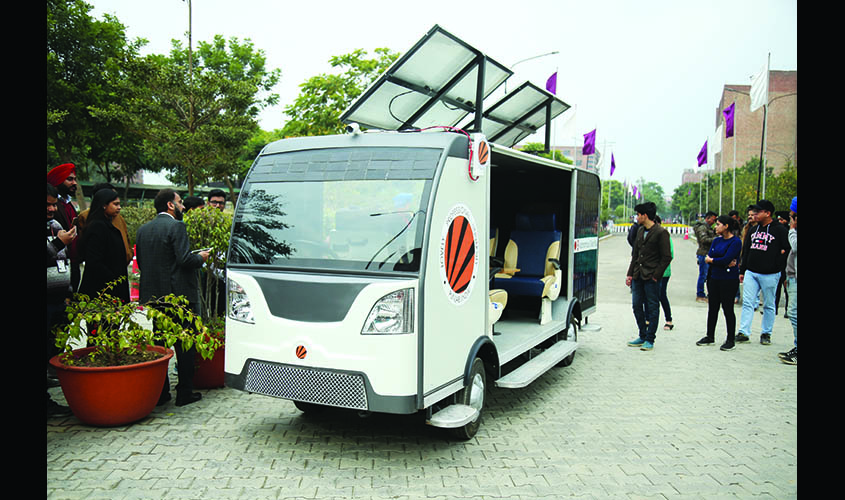Students of Lovely Professional University (LPU) have designed and built a driverless solar-powered bus to fight the energy crisis.
The first prototype of the bus was inaugurated by Human Resource Development Minister Prakash Javadekar at the Indian Science Congress hosted on the LPU campus on 3 January.
The driverless bus operates with the help of a technology called Vehicle-to-Vehicle (V2V) communication. And its engine runs on battery and solar power, at a negligible cost.
Explaining the science behind the bus, Mandeep Singh, project head, told Guardian 20, “Though our proposed prototype is based on sensors that are used in other driverless cars—such as GPS modules, ultrasonic sensors, Bluetooth modules, image processing etc.— its solar-powered runway capability makes it unique.”

The vehicle makes use of the GPS module Ublox NEO 8M for navigation purposes. This system coordinates with the bus’ camera sensors and router that works within a range of 20-30 kilometres. Some ultrasonic sensors have also been installed in the bus, to detect any obstacles on the programmed route. These sensors are in turn connected with a small single-board computer, called Raspberry-Pi, which collects and processes the input sent by the sensors.
The same technology processes the camera feeds linked to the on-board Raspberry-Pi.
The Raspberry-Pi computer is at the heart of this driverless bus. It serves as the core of the control mechanism and processes all inputs, programmes all routes, and sends instructions to the vehicle’s actuators, which control acceleration, braking and steering.
The motor used in the bus is a BLDC motor that produces 10KW power and can run for 60-70km after one charge. The bus can also be controlled through GPS and Bluetooth within a radius of 10 metres. The motor controller adjusts the amount of energy that flows to the motor to correspond to the throttle.
The bus can seat 10-30 passengers as of now. According to Mandeep Singh, “The driverless bus is an eco-friendly invention which is expected to reduce the running costs, as it is completely driven by solar power. It has a maximum speed of 30 kmph.”
Unlike hybrid vehicles that use internal combustion engines along with electric motors, this bus designed to be “completely pollution free”, claimed Singh, “and uses only renewable energy in the form of electric motor and solar power for propulsion.”
Solar panels, of 2KW energy capacity, have been installed on the bus. Whatever power they generate is stored in solar batteries which can power a trip of up to 60-70km in one complete charge.
Students from multiple academic fields within the LPU, like mechanical, electrical and computer engineering, collaborated in the design and construction of this vehicle.

Talking about whether the driverless bus can be commercially utilised anytime in the future, Singh said, “It is quite impossible to make the bus operational on Indian roads due to various issues, but the bus is going to be operational at airports and hospitals, and also on company premises, universities etc. Places where the path for the bus is quite fixed and hurdle-free.”
After its recent unveiling at the Indian Science Congress, the prototype is now being upgraded and improved by its designers. “The output like ultrasonic sensors will be replaced by lidar or radar system after proper analysis. And in regard to the solar tracking system, we are going to avoid the problem of partial shading during cloudy days by using Particle Swarm Optimisation or a combination of two soft computing techniques so that our efficiency could be increased,” Singh said about the proposed changes.
While many private individuals and engineering institutes are doing several experiments to bring driverless cars in commercial use, this is perhaps the very first time that a next-gen technology has been used in relation to buses.
The students took one complete year to build the prototype. The whole process was carried out at the LPU’s “Innovation Studio”, a university platform that helps students develop their ideas into working physical prototypes.
“The driverless bus is another example of LPU students being at the forefront of technology. Some other interesting projects done by LPU students include Flying Farmer, a wireless sensor device exclusively used in farming and field survey; as well as Formula One car and Go-karts,” said Ashok Mittal, Chancellor of LPU.
After going through the several upgrades in the trial phase, the eco-friendly solar-powered bus will be launched commercially at airports, industrial complexes and smart cities later this year.

